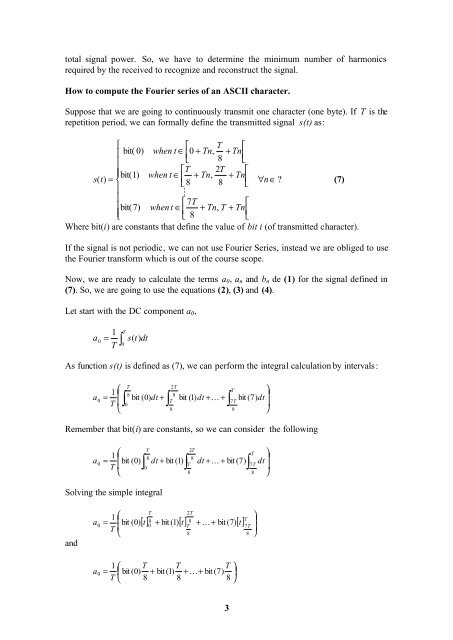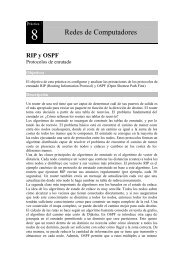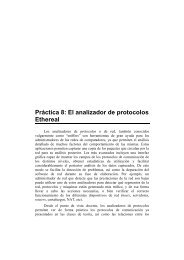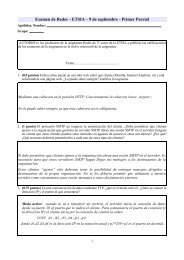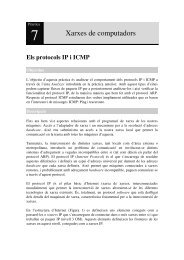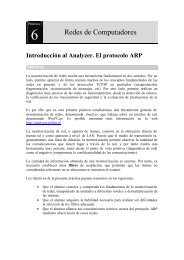Fourier Analysis - Redes de Computadores - UPV
Fourier Analysis - Redes de Computadores - UPV
Fourier Analysis - Redes de Computadores - UPV
Create successful ePaper yourself
Turn your PDF publications into a flip-book with our unique Google optimized e-Paper software.
total signal power. So, we have to <strong>de</strong>termine the minimum number of harmonics<br />
required by the received to recognize and reconstruct the signal.<br />
How to compute the <strong>Fourier</strong> series of an ASCII character.<br />
Suppose that we are going to continuously transmit one character (one byte). If T is the<br />
repetition period, we can formally <strong>de</strong>fine the transmitted signal s(t) as:<br />
⎧<br />
⎡ T ⎡<br />
⎪ bit( 0)<br />
when t ∈ ⎢0<br />
+ Tn,<br />
+ Tn⎢<br />
⎪<br />
⎣ 8 ⎣<br />
⎪<br />
⎡T<br />
2T<br />
⎡<br />
s(<br />
t)<br />
=<br />
bit( 1)<br />
when t ∈<br />
⎨<br />
⎢ + Tn,<br />
+ Tn⎢<br />
⎣8<br />
8 ⎣<br />
⎪<br />
M<br />
⎪<br />
⎪<br />
⎡7T<br />
⎡<br />
bit( 7)<br />
whent<br />
∈<br />
⎪<br />
⎢ + Tn,<br />
T + Tn⎢<br />
⎩<br />
⎣ 8<br />
⎣<br />
∀n∈<br />
?<br />
(7)<br />
Where bit(i) are constants that <strong>de</strong>fine the value of bit i (of transmitted character).<br />
If the signal is not periodic, we can not use <strong>Fourier</strong> Series, instead we are obliged to use<br />
the <strong>Fourier</strong> transform which is out of the course scope.<br />
Now, we are ready to calculate the terms a0, an and bn <strong>de</strong> (1) for the signal <strong>de</strong>fined in<br />
(7). So, we are going to use the equations (2), (3) and (4).<br />
Let start with the DC component a0,<br />
a<br />
0<br />
1<br />
=<br />
T<br />
∫<br />
T<br />
0<br />
s(<br />
t)<br />
dt<br />
As function s(t) is <strong>de</strong>fined as (7), we can perform the integral calculation by intervals:<br />
a<br />
0<br />
T<br />
2T<br />
1<br />
⎛<br />
⎜ 8<br />
8<br />
= bit ( 0)<br />
dt + bit ( 1)<br />
dt + K +<br />
⎜∫<br />
∫T<br />
T 0<br />
∫<br />
⎝<br />
8<br />
3<br />
T<br />
7T<br />
8<br />
⎞<br />
bit ( 7)<br />
dt⎟<br />
⎟<br />
⎠<br />
Remember that bit(i) are constants, so we can consi<strong>de</strong>r the following<br />
a<br />
0<br />
T<br />
2T<br />
1<br />
⎛<br />
⎜ 8<br />
8<br />
= bit ( 0)<br />
dt + bit ( 1)<br />
dt + K + bit ( 7)<br />
⎜ ∫ ∫T<br />
T<br />
0<br />
∫<br />
⎝<br />
8<br />
Solving the simple integral<br />
and<br />
a<br />
0<br />
1 ⎛<br />
= ⎜bit<br />
( 0)<br />
T ⎜<br />
⎝<br />
T<br />
2T<br />
[ t]<br />
8 + bit ( 1)<br />
[ t]<br />
8 + K + bit ( 7)<br />
[ t]<br />
0<br />
1 ⎛ T T<br />
T<br />
a0 = ⎜ bit ( 0)<br />
+ bit ( 1)<br />
+ K<br />
+ bit ( 7)<br />
T ⎝ 8 8<br />
8<br />
T<br />
8<br />
⎞<br />
⎟<br />
⎠<br />
T<br />
7T<br />
8<br />
T<br />
7T<br />
8<br />
⎞<br />
⎟<br />
⎟<br />
⎠<br />
⎞<br />
dt⎟<br />
⎟<br />
⎠


